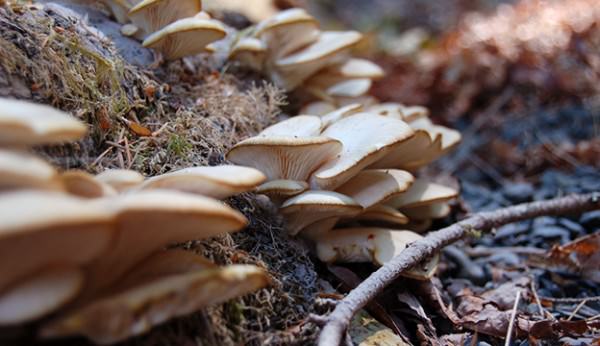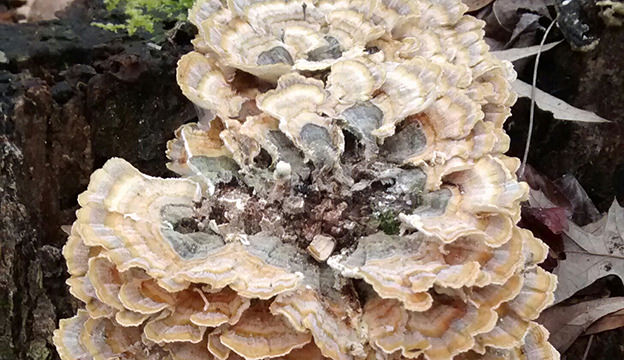
Foraging for wild foods isn’t something confined to the prime growing season. Mushrooms, in particular, can be found along the forest floor and growing on fallen logs in the colder months. So while you’re waiting for the season’s first seedlings to sprout, take a walk and hunt for these edible and medicinal mushrooms on your farm property.
Remember, if you’re new to mushroom, take along an experienced forager and a trusty mushroom-identification guide. Many edible mushrooms have poisonous look-alikes, so it’s important to know for certain what you’re gathering for food or medicine.
Oyster Mushrooms (Pleurotus ostreatus)
How to I.D.
Oyster mushrooms (pictured above) are common and relatively easy to identify. The white or pale-gray, fan-shaped mushroom grows in the wild, but it’s also a popular cultivated mushroom for beginning mushroom growers. Oysters grow in close clusters, often found on rotting tree trunks. A spore print, used to properly identify a mushroom, will be bright white for oysters.
Eating Oyster Mushrooms
Oyster mushrooms have a strong taste when eaten raw, but that mellows into a mild seafood flavor when cooked. Oyster mushrooms can be sautéed in butter and eaten as a side or added to a pasta dish. They are really great sautéed and then cooked down in a broth or white wine to be used as a sauce for a delicate fish.
Preserving Oyster Mushrooms
When oyster mushrooms are available, they are often available in abundance. If you find you have foraged more than you can eat, the best way to preserve these mushrooms is by drying them. Simply lay them in a single layer, gill-side up, on a cabinet protected with an absorbent paper. Put a fan directly on them and leave undisturbed until all of the moisture has evaporated. Once completely dried, store in a heavy-duty plastic bag. When you are ready to cook with them, remove the amount of mushrooms you want to use and submerge in warm water. Depending on the thickness of the mushroom, this will take 20 to 30 minutes. Once rehydrated, use as you would fresh mushrooms.
Medicinal Properties
Oyster mushrooms have antibacterial, antiviral and anti-hypertension properties. They are also a cholesterol reducer, a nerve tonic, and good for your cardiovascular system.
Wood Blewit (Lepista nuda)

How to I.D.
Wood blewit is typically found in the fall when the nights start to get cold. They grow around the base of oaks and in brush piles on the side of the road.
Identifying wood blewits is slightly trickier than identifying oyster mushrooms. Young specimens have a bluish or lavender color. Older specimens or those growing in the sun will be tan but will still have a bluish color in the gills. The stem can be enlarged at the base but it is not bulbous. The identifying spore print is white with a pink tint.
Eating Wood Blewits
Wood blewits should not be eaten raw. They have a unique flavor that holds up well in pork, fish, pasta or rice dishes. Before you decide which dish to add them to, sauté some for a taste test. Once you know what they taste like, it is easier to decide what recipe to add them to.
Grow Your Own
Wood blewits are easy to propagate. Put a fresh, clean mushroom in a jar filled with clean hardwood sawdust. Once you have mycelium growth, remove the mushroom and put the sawdust in compost-rich soil.
Lion’s Mane (Hericium erinaceus)

How to I.D.
This is by far the easiest mushroom to identify. It is a white, meaty, globe-shaped mushroom with cascading spines. You can occasionally find this mushroom in the spring, but you’ll have more luck finding it in the fall. They grow on many types of dead or dying hardwood trees, including maple, beech, oak, birch, walnut and sycamore. New specimens will be bright white, and as they age, the tips of their spines will turn brown.
Eating Lion’s Mane Mushrooms
This mushroom is extremely absorbent. Instead of trying to air dry it, go ahead and squeeze it like a sponge. To cook it, cut it into bite-sized pieces and sauté in butter or oil. Because Lion’s Mane tastes like lobster, you can use it anywhere you want a seafood flavor. It works well in pasta dishes, but my favorite thing to do with it after it has been cooked in a small amount of butter is to add it to a cup of tomato soup.
Medicinal Properties
Not only is Lion’s Mane delicious, it has some pretty amazing health benefits. Lion’s Mane is approximately 20 percent protein. Like other mushrooms, it has antibacterial and antiviral properties. It has also proven to be good for mood disorders, such as depression, though the most exciting research has shown it has notable nerve-regenerative and re-myelination properties, which would benefit those with neuro-degenerative diseases, such as Alzheimer’s and multiple sclerosis.
Artist’s Conk (Ganoderma applanatum)

How to I.D.
Artist’s conk is common on dead and dying hardwood trees, especially oak and maple. It is a woody, shelf-like mushroom and can grow quite large because it is a perennial and adds a new layer of tubes each year. There is a definitive test for identifying Artist’s Conk from other shelf-like mushrooms: When you take a stick and scrape the underside of this mushroom it will turn dark brown. Artists use the underside of this mushroom as a canvas, hence the name.
Medicinal Properties
Artist’s conk has laxative and diuretic effects. It is antibacterial and anti=inflammatory. It is beneficial for the lungs and respiratory system and has anti-tumor effects. It’s commonly used in a tea for medicine.
Turkey Tail (Trametes versicolor)

How to I.D.
Another mushroom great for use in a medicinal tea that is fairly easy to identify, turkey tail is colorful and grows on dead trees, logs, branches and stumps. It is a bracket fungi, meaning it forms thin structures in concentric circles. It’s a polypore, so instead of gills, it has small pores underneath from which it releases spores. True turkey tail has a white underside, which is the best way to distinguish it from it’s look-alike, false turkey tail, which has a tan underside.
Medicinal Properties
Turkey tail is antibacterial, antioxidant, anti-tumor, and antiviral. It is immunoboosting and has been used as a kidney and liver tonic. It has been successfully used in medical trials to treat the human papillomavirus (HPV) and hepatitis C.
Make a Medicinal Mushroom Tea
To make a medicinal tea from turkey tail or artist’s conk, chop into manageable pieces, rinse under cold water and simmer until tea is fairly dark and strong-tasting. You can add vegetables, chicken, fish or red meat to the tea broth in order to make a medicinal mushroom soup.
I encourage you to try one or all of these mushrooms. They have such great flavor and health benefits. If you forage for them, all the better.




